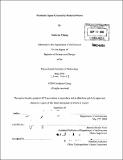Prosthetic space created by material weave
Author(s)
Chang, Soohyun
DownloadFull printable version (6.296Mb)
Other Contributors
Massachusetts Institute of Technology. Department of Architecture.
Advisor
Jeannie Meejin Yoon.
Terms of use
Metadata
Show full item recordAbstract
The thesis is based on physical interactivity between a user's physical body and the built environment. The relationship between body and architecture is challenged by the demands and desires for adaptability and interactivity, however material and construction methods of architecture have changed little to address these concerns. By allowing the user to become an instigator and an active controller for organizing space and program. Architectural elements are enabled with flexibility and mutability, in terms of its skin and program, which are activated by the user. The first investigation explores three joints within the body and documents, analyses and transforms these joints into an architectural abstraction. Then the concept of collapsed and interactive skin is applied to a design proposal for the fagade for the Art Interactive Gallery. The fagade engages pedestrians visually as well as physically. The final component of the thesis redefines the program of a fitting room as a physically transformable and socially interactive fagade condition activated by the body's own movements. Throughout the research, the thesis has focused on the process of manipulating materials to create composite skin and structural conditions to further investigate the relationship between the body and architecture.
Description
Thesis: S.B., Massachusetts Institute of Technology, Department of Architecture, 2003. Cataloged from PDF version of thesis. Includes bibliographical references (unnumbered pages 41-42).
Date issued
2003Department
Massachusetts Institute of Technology. Department of ArchitecturePublisher
Massachusetts Institute of Technology
Keywords
Architecture.